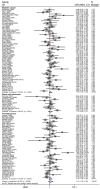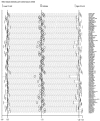GSTT1 Null Genotype Significantly Increases the Susceptibility to Urinary System Cancer: Evidences from 63,876 Subjects
- PMID: 27698905
- PMCID: PMC5039389
- DOI: 10.7150/jca.15494
GSTT1 Null Genotype Significantly Increases the Susceptibility to Urinary System Cancer: Evidences from 63,876 Subjects
Abstract
GSTT1 gene plays an important role in detoxification and clearance of reactive oxygen species(ROS). A null variant in this gene has been demonstrated to confer cancer susceptibility. Although many studies have demonstrated the association between GSTT1 null polymorphism and urinary system cancer susceptibility, several publications reported opposite conclusions. For better understanding the effects of this polymorphism on the risk of urinary system cancer, a updated meta-analysis was performed with a total of 26,666 cases and 37,210 controls extracted from 117 studies, by following the latest meta-analysis guidelines (PRISMA). The results suggested that the GSTT1 null genotype was significantly associated with an increased risk of urinary system cancer (OR=1.13, 95%CI=1.05-1.22). Furthermore, stratified analyses by the type of cancer, ethnicity, source of control and quality score presented a significantly increased risk associated with GSTT1 null genotype in bladder and prostate cancer subgroup, Caucasians and Indians subgroup, population-based(PB) subgroup, medium quality and low quality subgroup. Overall, our meta-analysis suggested that GSTT1 null genotype is a potential cancer susceptibility variant. Well-designed and large-cohort studies are needed to confirm the association between GSTT1 null genotype and urinary system cancer risk.
Keywords: GSTT1; meta-analysis; oxidative stress; polymorphism; susceptibility; urinary system cancer.
Conflict of interest statement
The authors have declared that no competing interest exists.
Figures






Similar articles
-
GSTM1 and GSTT1 polymorphisms are associated with increased bladder cancer risk: Evidence from updated meta-analysis.Oncotarget. 2017 Jan 10;8(2):3246-3258. doi: 10.18632/oncotarget.13702. Oncotarget. 2017. PMID: 27911277 Free PMC article.
-
Association between the Glutathione-S-transferase T1 null genotype and esophageal cancer susceptibility: a meta-analysis involving 11,163 subjects.Oncotarget. 2018 Feb 20;9(19):15111-15121. doi: 10.18632/oncotarget.24534. eCollection 2018 Mar 13. Oncotarget. 2018. PMID: 29599931 Free PMC article.
-
Glutathione S-transferase T1 polymorphism contributes to bladder cancer risk: a meta-analysis involving 50 studies.DNA Cell Biol. 2012 Jul;31(7):1187-97. doi: 10.1089/dna.2011.1567. Epub 2012 Feb 17. DNA Cell Biol. 2012. PMID: 22339266
-
Association of GSTT1 and GSTM1 polymorphisms with early pregnancy loss in an Indian population and a meta-analysis.Reprod Biomed Online. 2013 Apr;26(4):313-22. doi: 10.1016/j.rbmo.2012.12.004. Epub 2012 Dec 22. Reprod Biomed Online. 2013. PMID: 23433732 Review.
-
Association of genetic polymorphism of glutathione S-transferase (GSTM1, GSTT1, GSTP1) with bladder cancer susceptibility.Urol Oncol. 2013 Oct;31(7):1193-203. doi: 10.1016/j.urolonc.2011.11.027. Epub 2011 Dec 11. Urol Oncol. 2013. PMID: 22154357
Cited by
-
Significance of GSTM1 and GSTT1 Gene Deletions in Glioma Patients in Polish Population: Pilot Study.Clin Med Insights Oncol. 2025 Apr 21;19:11795549251330712. doi: 10.1177/11795549251330712. eCollection 2025. Clin Med Insights Oncol. 2025. PMID: 40291839 Free PMC article.
-
Gene polymorphisms associated with immunosuppressant adverse effects in systemic lupus erythematosus: a narrative review.Front Genet. 2025 Jun 24;16:1594648. doi: 10.3389/fgene.2025.1594648. eCollection 2025. Front Genet. 2025. PMID: 40630120 Free PMC article. Review.
-
Impact of GSTT1 and GSTM1 Polymorphisms in the Susceptibility to Philadelphia Negative Chronic Myeloid Leukaemia.Curr Cancer Drug Targets. 2023;23(4):319-324. doi: 10.2174/1568009623666221027103845. Curr Cancer Drug Targets. 2023. PMID: 36305131
References
-
- Stewart BW, Wild CP. World Cancer Report 2014. Lyon, France: International Agency for Research on Cancer; 2014. - PubMed
-
- Moore LE, Wilson RT, Campleman SL. Lifestyle factors, exposures, genetic susceptibility, and renal cell cancer risk: a review. Cancer Invest. 2005;23:240–55. - PubMed
-
- Thier R, Golka K, Bruning T. et al. Genetic susceptibility to environmental toxicants: the interface between human and experimental studies in the development of new toxicological concepts. Toxicol Lett. 2002;127:321–7. - PubMed
-
- Strange RC, Spiteri MA, Ramachandran S. et al. Glutathione-S-transferase family of enzymes. Mutat Res. 2001;482:21–6. - PubMed
-
- Dusinska M, Staruchova M, Horska A. et al. Are glutathione S transferases involved in DNA damage signalling? Interactions with DNA damage and repair revealed from molecular epidemiology studies. Mutat Res. 2012;736:130–7. - PubMed
LinkOut - more resources
Full Text Sources
Other Literature Sources

